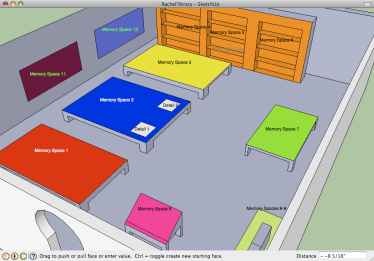Take a deep breath...
Hold it for ten seconds, then slowly exhale. Take a few seconds to think and calm down a little. Is this even worth your time and emotions? If so, what can you do to resolve this with the least amount of damage? If it's not worth getting frazzled over, go blow off your steam elsewhere.
Always attack the problem, not the person
If you are approaching the situation as a problem to be solved, both parties are less likely to get defensive. If you are pointing your finger at her, she will either shut down or lash out, which causes more drama. For example, if you're tired of your roommate bringing guests to your place while you're studying, don't accuse her of being rude or inconsiderate. Talk about the issue. You're stressed out about an upcoming exam, and having people there is distracting you from preparing for it. Sounds more productive, right?
 |
| Put away the big guns, girl! Can't we talk about this? |
Try to see her point of view
You don't have to agree with her, just try to affirm why she feels the way she does. Maybe she's completely overwhelmed with her workload. Maybe she just broke up with her boyfriend. Maybe her cat hates his Kitten Mittens (Any Always Sunny fans out there?). In nursing, we're taught how to use open-ended questions to gather information and help our patients discover more about themselves. You can use this same tactic with everyday conflicts. "You seemed upset when I said ___," "What are you doing to make ____ more manageable?" "What can I do to help you feel better?" Try to avoid "why" questions, since they usually put people on the defensive moreso than simply asking, "Tell me about ___."
Now give your opinion
Once she's explained herself, it's time to tell your side of the story. Remember to speak carefully, focusing on yourself and the problem, not so much what she has done. "I feel stressed out when the tv is loud while I'm studying," or "I really appreciate when be both do our share of the cleaning."
Lay down ground rules before drama even starts
In my cooperative house, we have roommate agreement forms that all the roommates fill out together, sign, then turn in to the house president. These contracts address anything from music volume, to food storage, to guests, to cleaning and organization, anything. If you're not living in a co-op or sorority, there's obviously not a way to enforce an agreement like this, but if something comes up that you both discussed and wrote down beforehand, it's easier to point to that piece of paper with her John Hancock on it than to put her on the spot.
Be willing to compromise
You can't expect to get your way all the time, and neither can she. It's always best to figure out what's most important to everyone, and sort things out from there.
If the issue doesn't involve you, then stay out of it
You are Switzerland on the continent of Roommates. Do not pick sides or gossip about it. The only situations in which you should get involved is when someone is engaging in potentially harmful or destructive behavior. Even then, don't let yourself get emotionally compromised. Stay objective. If you get caught in the middle, someone will always end up resenting you, too.
Avoid giving unsolicited advice
This is the one I need to work on the most. As a nursing student and an "older" sister to most of the girls in my house, I feel like it's my calling to take care of people, and this sometimes means I don't keep my distance when I should. Instead of telling someone what to do, first ask, "What do you think you should do?" If she isn't sure, then it's a better time to put on the nurse's hat.
Stay Present
Don't wait until a week after something happened to finally confront someone about it, and don't recall issues that have already been settled. Bringing up the past is unfair, and neither of you will remember exactly what happened. Also, waiting to solve the problem will only make it eat at you, so you're more likely to lash out at the person instead of trying to productively solve the conflict.
 |
| Less drama, more fun with mustache band-aids |
Forgiving isn't forgetting that an injustice occurred, it's letting go of your desire to get even or watch them suffer for it. Don't say that you forgive somebody just to superficially fix the relationship. Truly give up your right to be angry so the hate doesn't poison you. Resentment is like eating rancid meat and waiting for the other person to get green in the face. At the end of the day, you're the one hugging the toilet.
Last but not least, don't forget to laugh at yourself! A little sense of humor will go a long way in making situations feel less tense. I hope you find these communication skills to be as helpful as I do for keeping drama to a minimum! Good luck! ^_^










